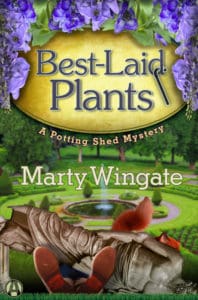As evidence of the circle of life, I would submit a host of short stories, such as “Santa’s Lost Sleigh” and a Halloween ghost story, penned during elementary school recess, written by a girl who dreamed of being the next Jo March–with or without the endearing German professor. A writer I was at nine years of age, and a writer I am this many years later–with a digression or two along the way.
A chronicler of facts
For many years, I wrote nonfiction. I started out in high school and college journalism with dreams of wearing a trench coat and being called away to follow exciting news stories (before being temporarily lured away by the theater). After that, I wrote a weekly newspaper feature, magazine articles, and books—specifically, how-to guides to gardening.
A friend plants a seed
A friend–with whom I always discussed books, many of them mysteries–suggested I write my own mystery series with a gardening theme. I thought she was nuts. Still, I began to think hard on this fiction business, and a question arose: How would I ever be able to make up a story long enough to be considered a book?
Stories within stories
Most of my nonfiction work had run from 800 to 1,000 words. Two mystery series and ten novels later, my novels hit the 80,000 to 84,000 mark every time–and this without a fight. I believe it has something to do with using the same story template, only on a broader scale. Everything’s a story, even how to plant a tree. The novel is a series of interwoven stories.
Also, I pay close attention to word count. Even if I don’t know what will happen in the next scene, I know where my word count should be at every stage of the book.
Before publishing The Garden Plot in 2004, my second reaction to the idea of fiction writing was that I would be free–I could write anything I wanted and it didn’t have to be true. I got to make it all up!
I discovered that wasn’t quite true: restrictions apply.
More research
Both my series are set in England, but I am not, and so I am careful to do thorough research–much of it on the ground. I may make up villages and pubs. Also, one of my favorite things is to invent very English pub signs. However, when it comes to gardens and birds–the themes of the series–I am steeped in the truth.
What reader wants to be stopped by incorrect information about one of their favorite subjects? That’s why I’ll never plant an olive tree outdoors in the north of Scotland or a bird where it doesn’t belong. Unless it’s a rare bird sighting—perhaps a bee-eater or a hoopoe. If that’s the case, I’ll get a twitcher–one of those ultimate bird watchers–on it.

 Best-selling author Marty Wingate shares her love of Britain in two mystery series, the Potting Shed books, featuring Pru Parke, a middle-aged American gardener transplanted from Texas to England, and Birds of a Feather, following Julia Lanchester, bird lover, who runs a tourist office in a Suffolk village. Marty also leads garden tours to Britain, spending free moments deep in research for her books. Or in pubs.
Best-selling author Marty Wingate shares her love of Britain in two mystery series, the Potting Shed books, featuring Pru Parke, a middle-aged American gardener transplanted from Texas to England, and Birds of a Feather, following Julia Lanchester, bird lover, who runs a tourist office in a Suffolk village. Marty also leads garden tours to Britain, spending free moments deep in research for her books. Or in pubs.





